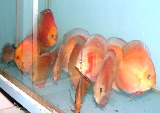 I thought he would have one or two fish tanks of discus
as his address was a humble 2-bedroom Housing
and Development Board (HDB) apartment. He
was residing in the smallest of the HDB apartment
configurations. There would be no space for fishes as he
had a family and furniture. I thought he would have one or two fish tanks of discus
as his address was a humble 2-bedroom Housing
and Development Board (HDB) apartment. He
was residing in the smallest of the HDB apartment
configurations. There would be no space for fishes as he
had a family and furniture.
A fish breeder in Singapore usually has a sprawling farm land
as exemplified by the Qian Hu Corporation, qianhu.com,
a Singapore stock-exchange listed ornamental fish
exporter and a Singapore agricultural
success story.
I visited him in 2001. I was
pleasantly surprised to see over a thousand very beautiful
and healthy discus in the HDB heartland of Toa Payoh, an
estate of over 50 years old located in central
Singapore.
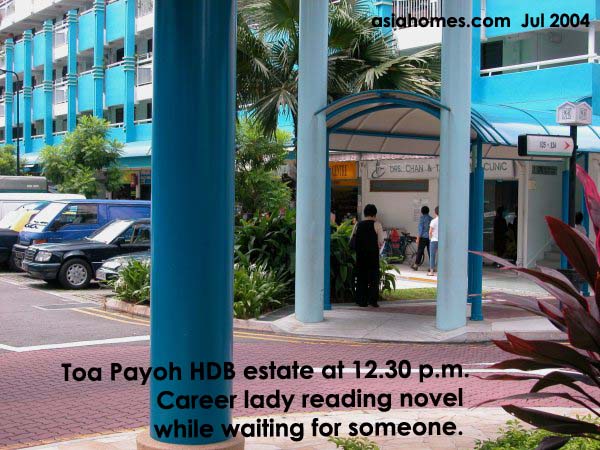 |
| Upgraded
2-bedroom Toa Payoh Estate HDB apartments
beautified with vertical columns outside common
balconies. Passer-bys can peep into the
windows of the bedroom 2 and living area when
the walk along the balconies. In 2004, covered
walk ways and tiled roads beautify the
estate. Retail shops on ground floor now
seldom seen in the newer HDB residential estates
as they are now centralised in a common block or
shopping mall. |
The fish tanks may be old, but the fishes are in
excellent condition and looked vigorous. The
breeding tanks are kept in bedroom 2 while the other
bedroom is used by the couple. The living cum
dining room and the kitchen are stacked with fish
tanks.
Nowadays, the internet, especially the websites of
discus breeders and wholesalers of ornamental fishes,
provides a large wealth of information on discus
breeding. The National Library of Singapore has
various branches and there are fish magazines for
loan. It is much easier to acquire knowledge on
discus breeding and I would not be writing on how to
breed discus.
As a picture tell a thousand words, I have published his
fishes and set up to inspire students who love fishes
But who think that they don't have the space
to pursue their passion. |
 |
| For
beginners, the turquoise makes ideal first
discus. The turquoise discus is the
"traditional" type and are hardy and
easiest to keep. |
Know what the
global market wants
One means of supplementing the family income
is the breeding high quality
ornamental fishes that are in great demand by the world
and by the local pet shops. Mr Ng is
successful because he breeds what the export market
wants - healthy attractive clean discus fishes.
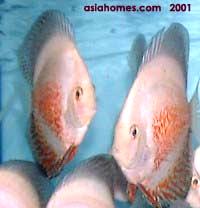 |
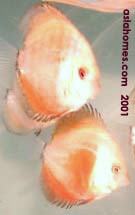 |
| New
colourful strains of discus always interest
buyers. Most discus have
"soot" or "carbon marks" but
Mr Ng's strains are clean. |
A
new favourite discus is the red diamond. Novices
mistake it for a marine fish as it has bright
red colours. |
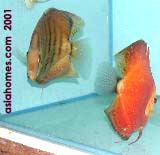 |
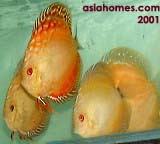 |
| Mr
Ng's discus breeds different colourful strains
from his HDB apartment. |
It is a hobby
which gives much pleasure if you have a passion for
fishes and the interest to do research and development
to create new strains. The investment is not great if you do it
at home. A good draining and filtration system is
important as fishes need the right amount of oxygen and
soft water conditions. You do not need to pay the
high rentals or the costs of heating of the water as Singapore
has a high temperature. Daily changes of
water for the growing fishes are important. Start
breeding with the hardy turquoise strains and learn by
doing it to gain valuable hands-on experience.
 |
Red
strains are in demand and are often mistaken by
novices as marine fishes. You can supplement
your income by breeding discus
in a 2-bedroom HDB apartment. To succeed,
you must produce ornamental fishes that the
export market wants.
Fishes don't bark and become a noise
nuisance resulting in regulatory authorities
inspecting the apartment and issuing
summons. |
HDB rules
inhibit entrepreneurship
The window
shutters of the bedroom with the breeding tanks had to be shut as the passers-by
might peep in from the common corridor. I did not
ask Mr Ng, but I think some residents may complain to
the HDB authorities about Mr Ng's commercial activity as
HDB flats are meant to be for residential use only. So
it is best to close the windows.
However, breeding stock should be kept in a quiet
environment. In 2003, a restricted number of
businesses are permitted in HDB apartments, but discus
breeding may not qualify.
Excellent management of fishes
Discus are said to be hard to rear and keep. Mr Ng's discus looked very healthy and the colours took my
breath away. No doubt, his management of the
fishes are excellent or they will not look beautiful.
Mr Ng had 2 air
pumps, just in case one failed. He transported the fishes
on his scooter to the fish dealer after packing them in
oxygenated water in plastic bags. The above pictures were taken in 2001.
Know what the global market wants.
Mr Ng breeds strains in great demand by Europeans in 2004.
The golden dragons are newer strains and were produced
in the 1990s.
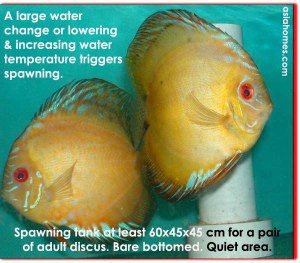 |
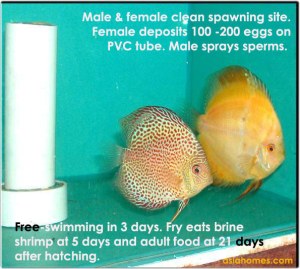 |
| Breeding
stock in bedroom 2. Lights are switched
off at night. Sprawning usually takes
place in the day. These discus are golden
dragons (or pigeons). |
A
breeding tank in bedroom 2. All new
strains are developed by experimenting such as
the keeping a golden dragon male with other
strains. |
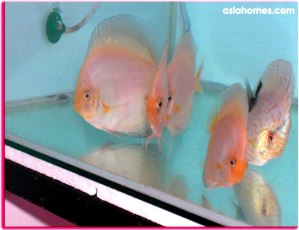 |
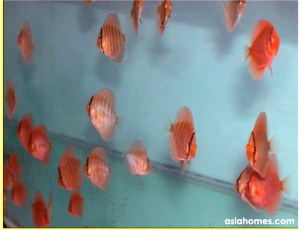 |
| The turquoise discus (right)
has a head bump making it unique. The
calico discus has been bred crossing snow white
variants with solid reds. They are in demand as
hobbyists like something different. It is
reasonably hardy and is recommended for
hobbyists with more breeding experience. |
Healthy
growing stock are fed once daily with just
sufficient amount of feed so as not to pollute
the water.. |
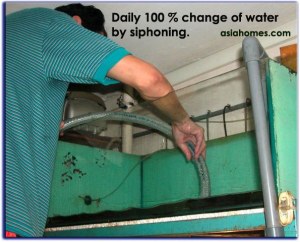 |
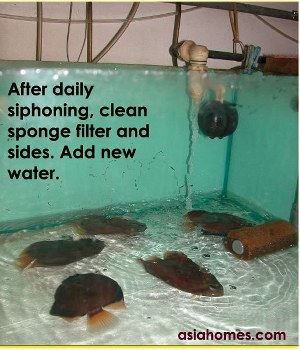 |
| Syphoning
water every day for the non-breeding stock. This
tank is in the kitchen. The end of the tube
is disinfected if the tank has sick fishes,
before using it on another tank. |
Tap
water added after syphoning to replace 100% of
the water daily. Sick fishes can be treated with
medication. Water conditioner added later
to reduce the chlorine content in Singapore's
tap water. |
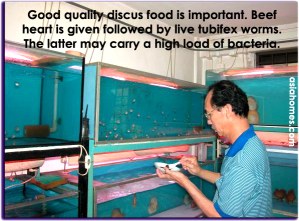 |
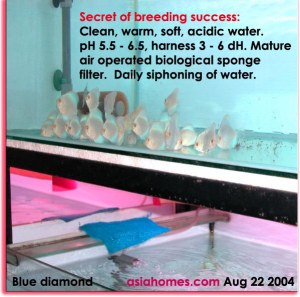 |
| Fish
tanks in the living area near the front door. Mr Ng had the right
formula to feed the discus for optimal growth
rate. Live worms seem to be
appropriate for his fishes although some
breeders worry about bacterial infection
introduced into the fish tanks by such worms. |
Fish
tanks for growing fishes in bedroom 2, sharing
space with breeding tanks. The blue discus
always look good and is easy to care for.
Mr Ng said that European hobbyists love the blue
beauties. |
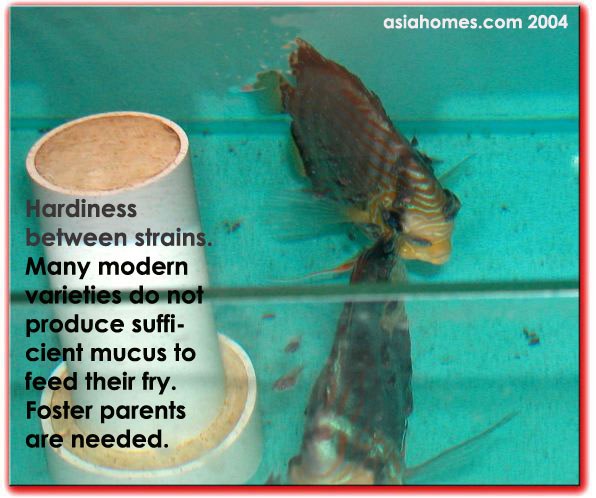 |
| Fry
feeding on the body mucus. Foster parents
like the turquoise discus may be needed if the
modern varieties are unable to produce mucus to
feed their fry. |
Hard work and
passion
You will need to persevere if you want to excel in what
you want to do. Nothing can substitute hard
work too. Mr Ng had been interested in discus
since he was sixteen years old. With passion and knowing what the world
wants, he started small. He re-invested his money
to grow his business. Now, he has a few thousand fishes.
A home is usually an expense, but in Mr Ng's case, his
home generates income and he does not need to sublet a
room and loses his privacy.
His children have grown up and he is still active
enjoying his hobby. His other sources of income
are from painting Buddha
statues in gold for others and a night-time job.
Now, Mr Ng breeds some red- eyed guppies originated from
Japan as they are in demand by pet shops. A pair
costs a hundred dollars. Since his compulsory
retirement from the police force at the age of 45, he
has never worried about earning an income to maintain
his family of a wife and two small dogs.
He does not need to worry about retrenchment after
reaching middle age. He is an entrepreneur in a
small way. Readers who are now motivated to start
a business from home at a young age may wish to
appreciate the bigger pictures of his beautiful discus
strains. Goto: www.asiahomes.com/koiclinic/0805discus_breeding.htm.
 Readers
who wish to share their experiences in the breeding of
discus at home or wish to contact Mr Nelson Ng,
please email to judy@sinpets.com. Readers
who wish to share their experiences in the breeding of
discus at home or wish to contact Mr Nelson Ng,
please email to judy@sinpets.com.
This educational article is sponsored by asiahomes.com,
"affordable homes for
expatriates". Pictures are © asiahomes.com.
Last updated: 10 Sep 2004
|